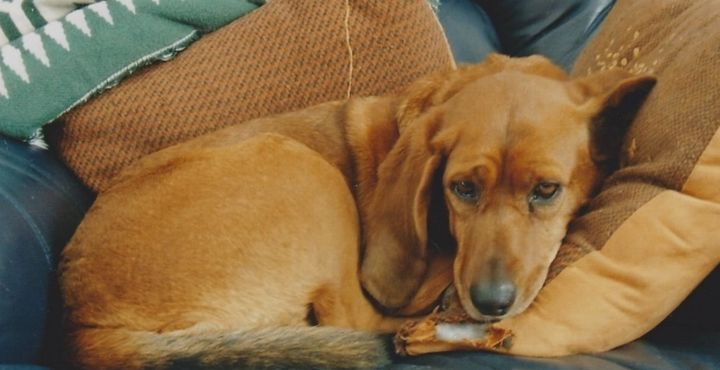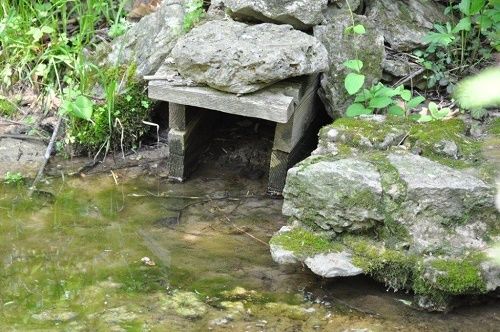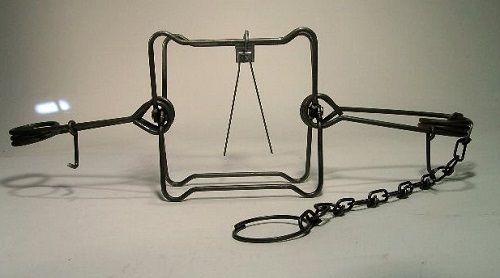
Copper
This article is dedicated to a sweet dog I never met. A beautiful 10 year-old rescue named Copper.
I first heard the story of what happened to Copper, last month. Laura Nirenberg, Executive Director of the Center for Wildlife Ethics (CWE), shared with me the details surrounding Copper’s untimely and brutal death. Copper was crushed by a hidden wildlife trap in Versailles State Park, a public park which is 5,988 acres in size, and visited by approximately 268,000 people a year.
The trap that violently killed Copper was, astonishingly, one of hundreds (or thousands) of devices hidden throughout public parks and sanctioned by the state of Indiana.
The specifics of Copper’s death may be difficult for some to read. I do understand, as this legal case was difficult for me to research and write. While the details are troubling, it is critical that the story of Copper’s death be told, as a similar tragedy could happen to anyone simply taking their beloved dog out into nature for a hike.
My goal for this article is to alert the public regarding the dangers of wildlife traps on lands held in the public trust. I remain hopeful that Justice for Copper can be achieved, as a result of the relentless persistence of CWE. The good work done by this grass-roots nonprofit reveals a bigger issue that needs to be addressed, which is Indiana Department of Natural Resources’ (IDNR) historical pattern of disregard for public notice and input, reckless indifference to public safety, and co-opting of public lands for private financial gain. In this case–benefiting those who trap wildlife for fur.
Copper’s Story
In 2011, Melodie Liddle lived in Holton, Indiana, a small town with a population of just under 500 people. Melodie lived in close proximity to Versailles, and visited the park frequently with her dogs and grandkids. She considered Versailles to be part of her community. It was a place she felt safe.
All that changed on December 16, 2011.This was the day that Melodie decided to take her two dogs, Copper and Pirty, out for an afternoon walk.
After enjoying a vigorous hike on an unseasonably warm day, her dogs were in need of a drink. Melodie took both leashed dogs down a trail to a creek where they lapped up the fresh water and sniffed around for a bit.
After a few minutes, Melodie decided to return home. As she turned to head back up the trail, she was startled by the blood curdling sound of Copper screaming in pain. Unsure of what was happening, Melodie dropped both leashes and jumped into the water to aid her shrieking dog, who was frantically twisting and flailing about in an attempt to break free of something.
It took Melodie a moment to realize that Copper was caught in some sort of trap. She later learned that a deadly, body crushing device known as a conibear trap like the one pictured below, had been hidden in a nondescript wooden box.

Box in Versailles State Park that hides a lethal conibear trap.

Conibear trap. This body crushing device is used by trappers to kill raccoons, beavers and other small mammals.
Alone in the woods, Melodie struggled desperately with the metal trap, battling to free her dog from the powerful steel bars that were clamped down tight on Copper’s neck and chest, crushing her airway.
After several minutes, Copper collapsed and died in Melodie’s arms.
Holding the lifeless body of her dog, Melodie continued her attempts to remove the trap. Despite her valiant efforts, she just wasn’t strong enough. (Melodie’s entire testimony of what happened that day can be found in this affidavit).
What then followed were several emotion filled minutes of Melodie attempting to phone for help, but was unable to, due to a lack of cell service in the area. Panicked and feverishly trying to get a signal, Melodie and Pirty walked approximately a quarter of a mile back to her car in the parking lot. Overcome with grief, she cried for about 10 minutes, and then called a nearby friend for help.
“When I reached the car, I just leaned against it and sobbed for about ten minutes, and then decided to call my friend Gene Beach to see if he could help me remove the trap from Copper. Gene answered the phone, but I could not stop crying and just kept blurting out, I think Copper is dead! And I think she was killed by a trap! Gene told me to calm down because he could not understand what I was saying due to my uncontrollable sobbing.” — excerpt from Melodie Liddle’s affidavit
When Gene was able to decipher what had happened, he drove right over to Versailles. (Gene’s full affidavit of what happened that afternoon can be found here.) Melodie took him to where Copper’s motionless body lay in the trap. Gene confirmed he thought Copper was dead, and proceeded to work to get the trap off of Copper. While he did this, Melodie went to notify the park officials that a trap hidden in the park killed Copper.
The callous and indifferent reactions of park officials when they learned of what happened are appalling.You can read the details in items #38 – 68 in Melodie’s affidavit. In a nutshell, park officials made no apologies, were defiant, and never provided a tort claim form as is customarily given to park patrons who suffer any type of loss on park property. Instead, the park officials made excuses for their decision to conceal deadly traps throughout the park.
IDNR’s insensitive reaction to Copper’s death, which was enabled by the hazardous condition created by the agency itself, is indefensible. IDNR deliberately failed to notify the public that deadly wildlife traps were hidden throughout the park, and justified this recklessness by claiming members of the public might steal the traps if notified of their presence. AND according to this internal memo released during the discovery process, intentionally kept the setting of lethal wildlife traps in state parks a clandestine practice. Below is an excerpt from the linked internal memo.
“Managers should be cautious when setting the conditions in which trapping is to take place. We don’t want this to become a public media issue. Trapping should be done in areas and times that aren’t directly in the public’s view for obvious reasons.” – IDNR internal memo dated November 3, 2005.
As the discovery process revealed, the agency’s pattern and practice of insensitivity continued. Following Copper’s death, an IDNR official called Ms. Liddle seemingly investigating, while feigning concern about, the tragedy her family had just endured. Melodie later learned this official was not serving in an investigatory capacity to help her, but rather shockingly, was the Director of Communications who recorded their telephone conversation without her knowledge or permission! (Click here to see the ethics complaint filed by CWE regarding illegal tape recording).
The Center for Wildlife Ethics – Fighting for Justice for Copper
For the last two years, the Center for Wildlife Ethics has been litigating this case, asserting that IDNR and the state employees responsible for this tragedy are liable for the death of Copper. In turn, the state has outrageously claimed IDNR and their employees are immune from liability. You can follow the progress of this case (Liddle vs. Clark, et al.) via the blogposts on CWE’s website.
Copper’s tragic death has attracted the concern of Indiana State Representatives Scott Pelath and Linda Lawson who sent this sharp letter of inquiry to the Executive Director of IDNR, Cameron Clark. As their letter demonstrates, the two Indiana legislators are asking the obvious questions about public safety, lack of notification, and both are urging IDNR to notify members of the public when traps are set, or discontinue their use entirely. In its response, IDNR claimed, ironically, to share “consideration for the safety of all of our guests.” The letter otherwise failed to address the substance of the lawmakers’ concern.
Why were these traps set in the first place? According to IDNR, camper complaints about “nuisance” raccoons demanded attention that warranted a little known regulatory action called an Emergency Rule. Emergency rules are enacted by an administrative agency without public input and are meant to be temporary. The problem is that IDNR enacted an Emergency Rule on the basis of no emergency at all, and unbelievably, did so for eight years!
When asked to turn over all raccoon-related complaints in discovery, IDNR only produced a small collection of “complaints,” some of which consisted of mere raccoon sightings, (including one specifying that raccoons were seen playing with each other and another observing that there did not seem to be many raccoons in the park). Suffice it to say, a handful of sporadic complaints from other state parks during random years dreadfully fail to warrant an emergency at Versailles in 2011. And, if complaints actually rose to the level of an “emergency” during the summer months of camping season, then why did IDNR mandate trappers wait until December to set traps?
You can read more about the original intent of this law, and its subsequent manipulation on the CWE blogpost, When a Fake “Emergency” becomes a Real-life Hazard
The Litigation Continues
CWE will be going forward to trial, seeking justice for Copper and Melodie, and to protect the public from dangerous wildlife traps. You can follow this case on CWE’s Facebook pages, or on their website.
UPDATE - A Go Fund Me Campaign was recently launched to help pay for legal expenses associated with this case. To learn more about how you can help, click here.

Melodie’s grandson Evan and Copper
